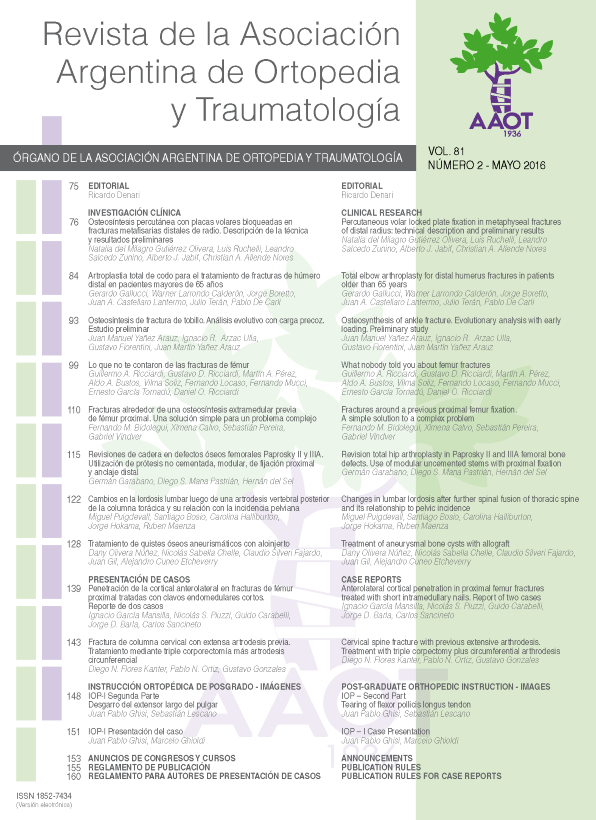Fracturas alrededor de una osteosíntesis extramedular previa de fémur proximal Una solución simple para un problema complejo. [Fractures around a previous proximal femur fixation. A simple solution to a complex problem].
Contenido principal del artículo
Resumen
Descargas
Métricas
Detalles del artículo

Esta obra está bajo licencia internacional Creative Commons Reconocimiento-NoComercial-CompartirIgual 4.0.
La aceptación del manuscrito por parte de la revista implica la no presentación simultánea a otras revistas u órganos editoriales. La RAAOT se encuentra bajo la licencia Creative Commons 4.0. Atribución-NoComercial-CompartirIgual (http://creativecommons.org/licenses/by-nc-sa/4.0/deed.es). Se puede compartir, copiar, distribuir, alterar, transformar, generar una obra derivada, ejecutar y comunicar públicamente la obra, siempre que: a) se cite la autoría y la fuente original de su publicación (revista, editorial y URL de la obra); b) no se usen para fines comerciales; c) se mantengan los mismos términos de la licencia.
En caso de que el manuscrito sea aprobado para su próxima publicación, los autores conservan los derechos de autor y cederán a la revista los derechos de la publicación, edición, reproducción, distribución, exhibición y comunicación a nivel nacional e internacional en las diferentes bases de datos, repositorios y portales.
Se deja constancia que el referido artículo es inédito y que no está en espera de impresión en alguna otra publicación nacional o extranjera.
Por la presente, acepta/n las modificaciones que sean necesarias, sugeridas en la revisión por los pares (referato), para adaptar el trabajo al estilo y modalidad de publicación de la Revista.
Citas
2. Mosheiff R, Leibner ED, Safran O, Peyser A, Liebergall M. Retrograde nailing of femoral fractures distal to previous osteosynthesis. J Orthop Trauma 2000;14(5): 367-9
3. Frost SA, Nguyen ND, Center JR, Eisman JA, Nguyen TV. Excess mortality attributable to hip fracture: a relative survival analysis. Bone 2013; 56(1):23-9
4. Camporesi EM, Greeley WJ, Lumb PD, Watkins WD. Chapter 9 Anesthesia. En: Sabiston Jr DC, editor. Textbook of surgery. 14 ed. Filadelfia: WB Saunders Company; 1991. P. 148-63
5. Kellam JF, Aidigé L. Fracture classification. En: Rüedi TP, Buckley RE, Moran CG (eds). AO Principles of Fracture Management, 2nd ed. Stuttgart and New York: Georg Thieme Verlag; 2007:69-85.
6. Collins S, Moore RA, McQuay HJ. The visual analogue pain intensity scale: what is pain in millimeters? Pain 1997;72:95-7.
7. Krupp R, Malkani A, Goodin RA, Voor M. Optimal entry point for retrograde femoral nailing. J Trauma 2003 Feb;17(2):100-5
8. Martinet O, Cordey J, Harder Y, Maier A, Bühler M, Barraud GE. The epidemiology of fractures of the distal femur. Injury 2000;31(Suppl 3):62-3.
9. Lippuner K, Golder M, Greiner R. Epidemiology and direct medical costs of osteoporotic fractures in men and women in Switzerland. Osteoporos Int 2005;16(Suppl 2):S8-S17.
10. Rina J, Tornetta P III, Ritter C, Geller J. Neurologic and vascular structures at risk during anterior-posterior locking of retrograde femoral nails. J Orthop Trauma 1998;12:379-81.

